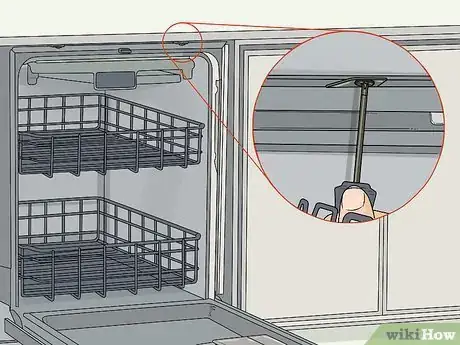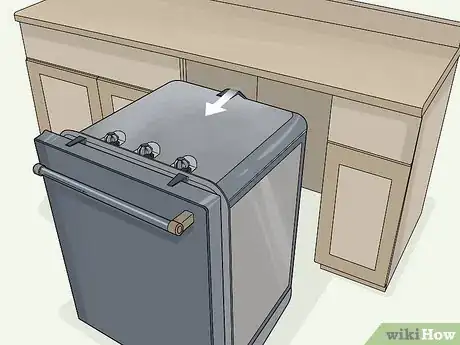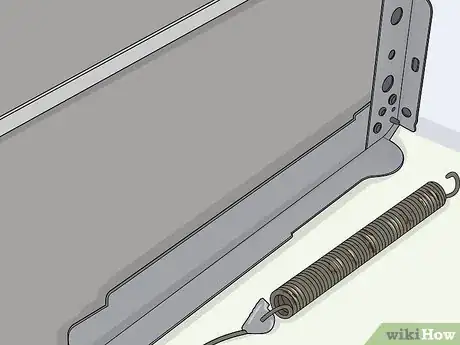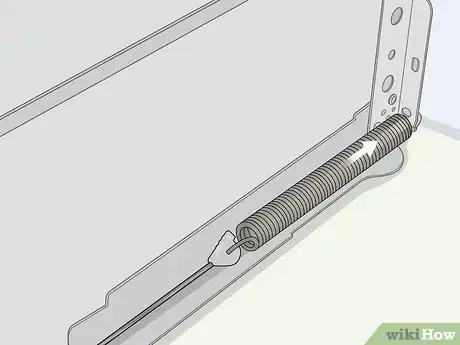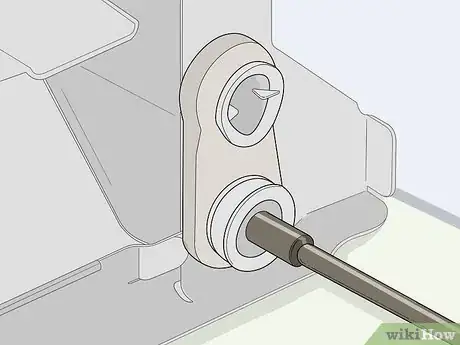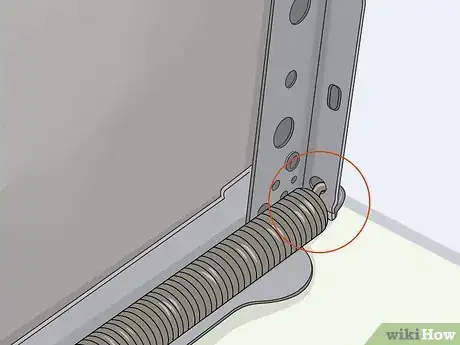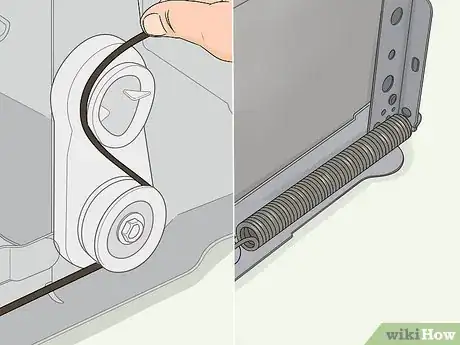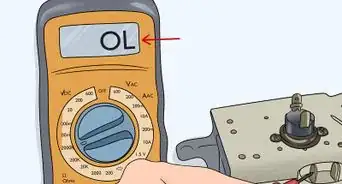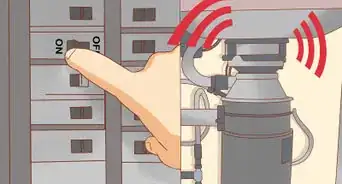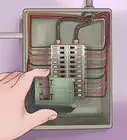This article was co-authored by Egor Shevtsov and by wikiHow staff writer, Eric McClure. Egor Shevtsov is a Home Improvement Specialist and Managing Partner at Appliance Techie in Orange County, California. With over seven years of experience, he specializes in maintaining and repairing appliances. He earned a Bachelor of Arts in Business Administration and Management from the International American University and a Master of Business Administration from the Russian University of Cooperation, former Moscow University of Consumer Cooperation.
There are 13 references cited in this article, which can be found at the bottom of the page.
This article has been viewed 23,773 times.
If your dishwasher door slams down immediately when you open it, your door spring or spring link kit may be need to be replaced. Dishwasher doors raise easily and lower slowly because there is a cord and pulley system connecting the bottom of the door to a spring on the back of the machine. If either the cord kit or the door spring break, the door won’t have any tension to stabilize it when you open or close it. So long as you get the right replacement part for your brand and model, you should be able to replace either of these parts in as little as 20-30 minutes. Unfortunately, you do need to take the dishwasher out of the cabinet since the rollers run along the side of the machine and the spring is on the back.
Steps
Accessing the Spring and Buying a Replacement
-
1Remove the screws at the top of the machine if it connects to the cabinet. Look underneath the lip of your cabinet near the front to see if the dishwasher has brackets that are screwed into the cabinet. If there are brackets holding it in place, grab a screwdriver and remove the screws to unlock the dishwasher from the cabinet.[1]
- If your dishwasher is connected to the cabinet with screws and your dishwasher moves when you try pulling it out, you can probably skip the next step. Most dishwashers are either anchored in the cabinet with screws or through the tension in the legs—they are rarely held in place using both methods.
-
2Unscrew the bottom cover plate and loosen the legs if necessary. Try pulling the dishwasher out a little to see if it moves. If it doesn’t, remove the 2 screws located on either side of the bottom cover plate, which is under the dishwasher door at the bottom. Slide the cover plate out from underneath your dishwasher. Then, use a wrench to loosen the platforms at the base of each leg to shorten the height of the dishwasher until you see a gap between the dishwasher and the cabinet.[2]
- The bottom cover plate keeps dirt and food scraps from getting kicked under the machine.
- Loosening these legs will lower the height of the dishwasher. This will give you enough room to slide dishwasher out of the cabinet.
Tip: Count the number of times that you turn each leg counterclockwise so that you can retighten the dishwasher to the exact same height that you originally had it at.
Advertisement -
3Slide your dishwasher out gently by pulling it from the top and bottom. Grab the bottom of the door with your dominant hand. Grip the top of the machine with your nondominant hand to brace it. Gently pull the dishwasher out of the cabinet. Continue pulling the dishwasher out until you can access the back of the machine.[3]
- Depending on how tightly the dishwasher is fitted into the cabinets, you may need to yank it back and forth to both sides to dislodge it.
- If the dishwasher was installed safely and properly, there should be enough slack with the water lines and power cord to slide it out all the way without taking your cabinets apart. If you’re worried there isn’t enough space, shut off your main water supply to prevent water from coming out of the supply lines when you remove the machine.
-
4Disconnect your garbage disposal hose if you feel any resistance. If you feel some kind of resistance at any point while you’re pulling the dishwasher out, there may not be enough slack in your garbage disposal line to pull it out. Go under your sink and find the clear tube running from the dishwasher to the garbage disposal. Either unscrew the bracket holding the garbage disposal hose in place under the sink, or simply slide it out of the port that connects it to the disposal. Let the hose hang at the bottom of the sink freely.
- If you recently ran your sink or did the dishes, stuff the hose with a clean towel or turn the hose over into a bucket to empty it before continuing.
-
5Inspect the cords along the side to see if the link kit is broken. The link kit runs along the outside of the machine at the bottom on each side. Look for a set of string with 2-3 pulley rollers holding the string in place on each side. If these strings are disconnected or the pulley rollers are broken, you need a new link kit.[4]
- The link kit connects the door spring to the bottom of the dishwasher door and provides tension when the door is opened to keep it from slamming down quickly.
- Check the link kits on both sides of the machine; there are normally 2 sets of links, with 1 on each side. While it’s rare for both of them to break, it’s certainly possible that you may need to replace both of them.
-
6Check the metal coils on the back to see if the door spring is damaged. If the link system is fine, look along the bottom of the machine on the back. Follow the cord on the link kit to the back and inspect the metal coil they connect to. If the metal spring connecting to the link kit cords is broken or bent, you need a new door spring.[5]
- The door spring expands and retracts when you open or close the door. When it expands or retracts, the link kit moves with it to brace the dishwasher door as it moves.
-
7Order a replacement door spring or link kit for your model. Open your dishwasher door and look for a sticker attached to the inside frame of the door. On this sticker, look for a model number. Use this model number to find a replacement door spring or link kit online. These pieces are not universal, so you need to buy a door spring or link kit for your specific dishwasher’s brand and model number.[6]
- The description for a replacement door spring or link kit will list the model numbers it will work with.
- The link kit is often called a pulley system or door cable.
- Both of these pieces typically cost $5-15 each.
Installing a New Door Spring
-
1Remove the old door spring from the frame. One end of the spring hooks on the cord of the link kit and the other end hooks directly on to the frame of the door. Pull the spring out 2–3 inches (5.1–7.6 cm) and slide the link kit cord off of the spring. Then, simply pull the other end of the spring off of the frame.[7]
-
2Attach the new spring to the end of the cord on the link kit. Take your new spring and slide the hole on the end of the link kit cord over the hook of the new door spring. Pull the door spring a little to make the link kit cord taut. Inspect the cord to make sure that it is still sitting along the grooves of each pulley roller.[8]
- The hooks of the door spring are symmetrical and identical. You can use either end of the door spring to do this.
Tip: The pulley rollers are the small discs that guide the link kit cord through the back and side of the machine. The cord must rest on the groove in the middle of each pulley roller. If the cord fell off of this track when you took the old spring off, put the cord back into place along the center of each roller.
-
3Pull the door spring far enough to hook on to the frame. Brace the end of the door spring that is connected to the link kit cord by holding it steady. Use your other hand to pull the end of the door spring out 2–3 inches (5.1–7.6 cm). Hang the second hook around the edge of the washer frame and slide the hook through the small hole on the frame where the original door spring was installed.[9]
- The tension from the door spring is more than enough to hold the hooks in place.
-
4Slide the dishwasher back into place and reconnect it. Gently slide the dishwasher back into place. If you unscrewed it from the cabinet, reinstall the screws. If you lowered the legs, use your wrench to readjust the legs until the top of the dishwasher is pressing against the top of the countertop. If you took the garbage disposal hose out, reattach it the same way you took it off.[10]
Swapping out the Link Kit
-
1Remove the old cord from the spring and door to pull it out. Unhook the end of the link kit cord from the door spring. Let the door spring hang in the door frame from the hole in the frame. At the bottom of the dishwasher door, there is a hook holding the other end of the cord on the door. Slide this part of the cord off of the hook. Then, simply lift out the old cord.[11]
- If you are replacing the link kit cords on both sides, you will need to repeat these steps on each side.
-
2Unscrew the old pulley rollers if they’re old or worn down. If the cord was broken but the round rollers that hold it in place are fine, you don’t need to replace them. If they look like they’re in rough shape though, grab a screwdriver or socket wrench and remove the screw or bolt in the middle of each roller. The pulley rollers will pop right out of the frame with the screws or bolts removed.[12]
- The pulley rollers are the 2 round discs that sit at the bottom of the frame on the back of the machine. When the door opens or closes, the rollers hold the cord connected to the door spring in place and keep it from sliding all over the place.
-
3Install the new pulley rollers using your new screws. The 2-3 pulley rollers usually come in one piece, so orient the rollers the same way they were previously installed. Push the pins on the back of the roller into the corresponding holes on the frame. Then, use your new screws to attach the rollers to the frame and hold them in place.[13]
Variation: If you only have 2 pulley rollers, you may need to slide the top roller into the slot on the frame with the bottom roller sticking out to the side to fit it into the slot. Then, rotate the bottom roller into position by using the top roller as a hinge. This style of link kit has an oddly-shaped peg on the top roller to lock it in place without a screw.
-
4Hang the link cord on the hook at the base of the door. Take one end of the link kit cord and hang it on the hook at the bottom of the dishwasher. Like the door spring, the link kit cord is typically identical on both sides, so you can hang either end of the cord on the hook.[14]
-
5Run the cord through the pulley rollers and hook it on your door spring. Starting on the end that is hooked on the door, pull the cord gently to keep it taut. Set the cord on the top pulley roller on the groove in the middle of the disc. Then, run the cord back under the top roller and pull it around the side of the bottom roller. Run the remaining length of cord to the door spring. Pull the door spring out 2–3 inches (5.1–7.6 cm) and hang the remaining end of the cord on the hook of the door spring.[15]
- When it’s hanging on the rollers, the cord should look like the letter S.
-
6Test the door and put the washer back where it originally was. Open and close the dishwasher door slowly. While you’re opening and closing it, watch the cord as it slides around the rollers. Once you’re sure that the cords are sliding around the pulley rollers correctly, slide the dishwasher back into place. Screw the dishwasher back into the cabinet or use your wrench to raise the legs again. Reattach the back panel and garbage disposal hose as needed.[16]
- Some link kits have a third roller in the middle of the frame to keep the cord from sliding around on the back of the machine. If you have one, place the cord on top of it when you attach the other end of the cord to the door spring.
Things You’ll Need
Accessing the Spring and Buying a Replacement
- Wrench
- Screwdriver
Installing a New Door Spring
- Replacement door spring
- Wrench
- Screwdriver
Swapping out the Link Kit
- Replacement link kit
- Wrench
- Screwdriver
References
- ↑ https://youtu.be/Z94SCyx6CFU?t=26
- ↑ https://youtu.be/Z94SCyx6CFU?t=58
- ↑ https://youtu.be/r4tI9K88dl0?t=120
- ↑ https://www.ikea.com/us/en/assembly_instructions/renlig-built-in-dishwasher__AA-2126152-1.pdf
- ↑ https://www.ikea.com/us/en/assembly_instructions/renlig-built-in-dishwasher__AA-2126152-1.pdf
- ↑ https://youtu.be/Z94SCyx6CFU?t=96
- ↑ https://youtu.be/r4tI9K88dl0?t=173
- ↑ https://youtu.be/r4tI9K88dl0?t=177
- ↑ https://youtu.be/r4tI9K88dl0?t=185
- ↑ https://www.ikea.com/us/en/assembly_instructions/renlig-built-in-dishwasher__AA-2126152-1.pdf
- ↑ https://youtu.be/X02l3pHeOUI?t=94
- ↑ https://youtu.be/X02l3pHeOUI?t=104
- ↑ https://youtu.be/X02l3pHeOUI?t=125
- ↑ https://youtu.be/X02l3pHeOUI?t=159
- ↑ https://youtu.be/X02l3pHeOUI?t=169
- ↑ https://www.ikea.com/us/en/assembly_instructions/renlig-built-in-dishwasher__AA-2126152-1.pdf
